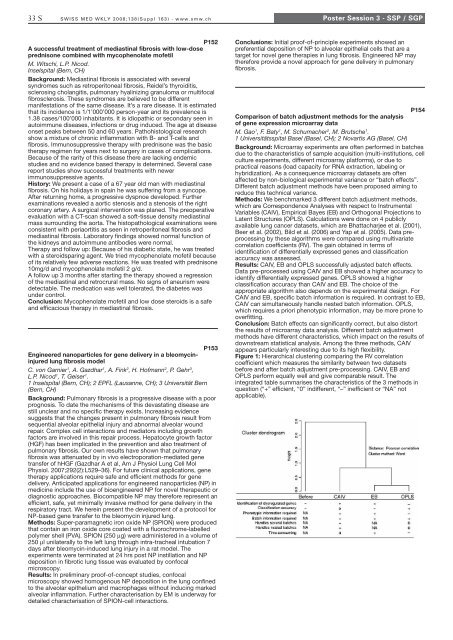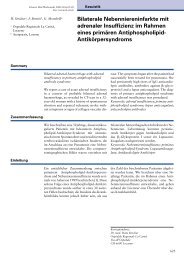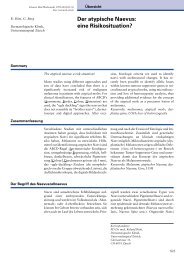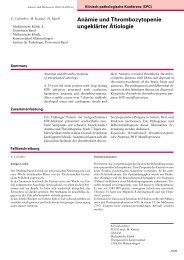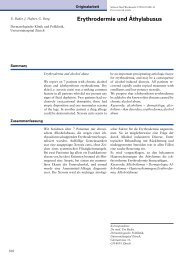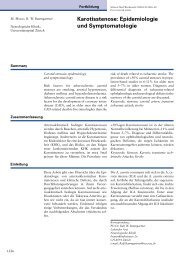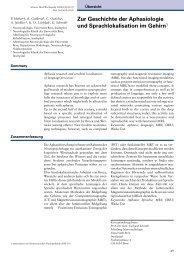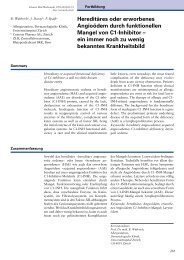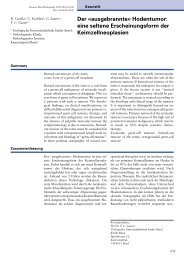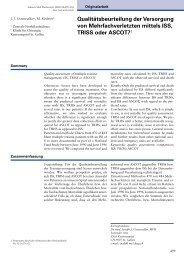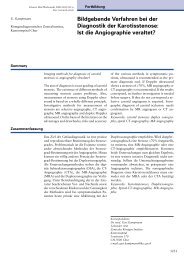Supplementum 163 - Swiss Medical Weekly
Supplementum 163 - Swiss Medical Weekly
Supplementum 163 - Swiss Medical Weekly
You also want an ePaper? Increase the reach of your titles
YUMPU automatically turns print PDFs into web optimized ePapers that Google loves.
33 S SWISS MED WKLY 2008;138(Suppl <strong>163</strong>) · www.smw.ch<br />
Poster Session 3 - SSP / SGP<br />
P152<br />
A successful treatment of mediastinal fibrosis with low-dose<br />
prednisone combined with mycophenolate mofetil<br />
M. Witschi, L.P. Nicod.<br />
Inselspital (Bern, CH)<br />
Background: Mediastinal fibrosis is associated with several<br />
syndromes such as retroperitoneal fibrosis, Reidel’s thyroiditis,<br />
sclerosing cholangitis, pulmonary hyalinizing granuloma or multifocal<br />
fibrosclerosis. These syndromes are believed to be different<br />
manifestations of the same disease. It’s a rare disease. It is estimated<br />
that its incidence is 1/1’000’000 person-year and its prevalence is<br />
1.38 cases/100’000 inhabitants. It is idiopathic or secondary seen in<br />
autoimmune diseases, infections or drug induced. The age at disease<br />
onset peaks between 50 and 60 years. Pathohistological research<br />
show a mixture of chronic inflammation with B- and T-cells and<br />
fibrosis. Immunosuppressive therapy with prednisone was the basic<br />
therapy regimen for years next to surgery in cases of complications.<br />
Because of the rarity of this disease there are lacking endemic<br />
studies and no evidence based therapy is determined. Several case<br />
report studies show successful treatments with newer<br />
immunosuppressive agents.<br />
History: We present a case of a 67 year old man with mediastinal<br />
fibrosis. On his holidays in spain he was suffering from a syncope.<br />
After returning home, a progressive dyspnoe developed. Further<br />
examinations revealed a aortic stenosis and a stenosis of the right<br />
coronary artery. A surgical intervention was planed. The preoperative<br />
evaluation with a CT-scan showed a soft-tissue density mediastinal<br />
mass surrounding the aorta. The histopathological examinations were<br />
consistent with periaortitis as seen in retroperitoneal fibrosis and<br />
mediastinal fibrosis. Laboratory findings showed normal function of<br />
the kidneys and autoimmune antibodies were normal.<br />
Therapy and follow up: Because of his diabetic state, he was treated<br />
with a steroidsparing agent. We tried mycophenolate mofetil because<br />
of its relatively few adverse reactions. He was treated with prednisone<br />
10mg/d and mycophenolate mofetil 2 g/d.<br />
A follow up 3 months after starting the therapy showed a regression<br />
of the mediastinal and retrocrural mass. No signs of aneurism were<br />
detectable. The medication was well tolerated, the diabetes was<br />
under control.<br />
Conclusion: Mycophenolate mofetil and low dose steroids is a safe<br />
and efficacious therapy in mediastinal fibrosis.<br />
P153<br />
Engineered nanoparticles for gene delivery in a bleomycininjured<br />
lung fibrosis model<br />
C. von Garnier1 , A. Gazdhar1 , A. Fink2 , H. Hofmann2 , P. Gehr3 ,<br />
L.P. Nicod1 , T. Geiser1 .<br />
1 Inselspital (Bern, CH); 2 EPFL (Lausanne, CH); 3 Universität Bern<br />
(Bern, CH)<br />
Background: Pulmonary fibrosis is a progressive disease with a poor<br />
prognosis. To date the mechanisms of this devastating disease are<br />
still unclear and no specific therapy exists. Increasing evidence<br />
suggests that the changes present in pulmonary fibrosis result from<br />
sequential alveolar epithelial injury and abnormal alveolar wound<br />
repair. Complex cell interactions and mediators including growth<br />
factors are involved in this repair process. Hepatocyte growth factor<br />
(HGF) has been implicated in the prevention and also treatment of<br />
pulmonary fibrosis. Our own results have shown that pulmonary<br />
fibrosis was attenuated by in vivo electroporation-mediated gene<br />
transfer of hHGF (Gazdhar A et al, Am J Physiol Lung Cell Mol<br />
Physiol. 2007;292(2):L529–36). For future clinical applications, gene<br />
therapy applications require safe and efficient methods for gene<br />
delivery. Anticipated applications for engineered nanoparticles (NP) in<br />
medicine include the use of bioengineered NP for novel therapeutic or<br />
diagnostic approaches. Biocompatible NP may therefore represent an<br />
efficient, safe, yet minimally invasive method for gene delivery in the<br />
respiratory tract. We herein present the development of a protocol for<br />
NP-based gene transfer to the bleomycin injured lung.<br />
Methods: Super-paramagnetic iron oxide NP (SPION) were produced<br />
that contain an iron oxide core coated with a fluorochrome-labelled<br />
polymer shell (PVA). SPION (250 mg) were administered in a volume of<br />
250 ml unilaterally to the left lung through intra-tracheal intubation 7<br />
days after bleomycin-induced lung injury in a rat model. The<br />
experiments were terminated at 24 hrs post NP instillation and NP<br />
deposition in fibrotic lung tissue was evaluated by confocal<br />
microscopy.<br />
Results: In preliminary proof-of-concept studies, confocal<br />
microscopy showed homogenous NP deposition in the lung confined<br />
to the alveolar epithelium and macrophages without inducing marked<br />
alveolar inflammation. Further characterisation by EM is underway for<br />
detailed characterisation of SPION-cell interactions.<br />
Conclusions: Initial proof-of-principle experiments showed an<br />
preferential deposition of NP to alveolar epithelial cells that are a<br />
target for novel gene therapies in lung fibrosis. Engineered NP may<br />
therefore provide a novel approach for gene delivery in pulmonary<br />
fibrosis.<br />
P154<br />
Comparison of batch adjustment methods for the analysis<br />
of gene expression microarray data<br />
M. Gao1 , F. Baty1 , M. Schumacher2 , M. Brutsche1 .<br />
1 Universitätsspital Basel (Basel, CH); 2 Novartis AG (Basel, CH)<br />
Background: Microarray experiments are often performed in batches<br />
due to the characteristics of sample acquisition (multi-institutions, cell<br />
culture experiments, different microarray platforms), or due to<br />
practical reasons (load capacity for RNA extraction, labeling or<br />
hybridization). As a consequence microarray datasets are often<br />
affected by non-biological experimental variance or “batch effects”.<br />
Different batch adjustment methods have been proposed aiming to<br />
reduce this technical variance.<br />
Methods: We benchmarked 3 different batch adjustment methods,<br />
which are Correspondence Analyses with respect to Instrumental<br />
Variables (CAIV), Empirical Bayes (EB) and Orthogonal Projections to<br />
Latent Structures (OPLS). Calculations were done on 4 publicly<br />
available lung cancer datasets, which are Bhattacharjee et al. (2001),<br />
Beer et al. (2002), Bild et al. (2006) and Yap et al. (2005). Data preprocessing<br />
by these algorithms were compared using multivariate<br />
correlation coefficients (RV). The gain obtained in terms of<br />
identification of differentially expressed genes and classification<br />
accuracy was assessed.<br />
Results: CAIV, EB and OPLS successfully adjusted batch effects.<br />
Data pre-processed using CAIV and EB showed a higher accuracy to<br />
identify differentially expressed genes. OPLS showed a higher<br />
classification accuracy than CAIV and EB. The choice of the<br />
appropriate algorithm also depends on the experimental design. For<br />
CAIV and EB, specific batch information is required. In contrast to EB,<br />
CAIV can simultaneously handle nested batch information. OPLS,<br />
which requires a priori phenotypic information, may be more prone to<br />
overfitting.<br />
Conclusion: Batch effects can significantly correct, but also distort<br />
the results of microarray data analysis. Different batch adjustment<br />
methods have different characteristics, which impact on the results of<br />
downstream statistical analysis. Among the three methods, CAIV<br />
appears particularly interesting due to its high flexibility.<br />
Figure 1: Hierarchical clustering comparing the RV correlation<br />
coefficient which measures the similarity between two datasets<br />
before and after batch adjustment pre-processing. CAIV, EB and<br />
OPLS perform equally well and give comparable result. The<br />
integrated table summarises the characteristics of the 3 methods in<br />
question (“+” efficient, “0” indifferent, “–” inefficient or “NA” not<br />
applicable).


